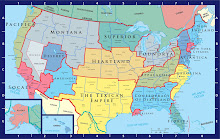(The Confederate States of Dixieland)

AREA
204,000 sq.m. (6th)
POPULATION
22,960,000 (5th)
DENSITY
113 people per square mile. (13th)
CAPITAL
Montgomery, Alabama
STATES
Georgia (Atlanta), Okefenokee (Macon), West Florida (Tallahassee), Magnolia (Mobile), Alabama (Montgomery), Cumberland (Birmingham), Mississippi (Jackson), Piedmont (Columbia).
RELIGION
Southern Baptist (official), Protestant
LANGUAGE
English
NATL INCOME
747 billion.
MEDIAN INCOME
$32,539 (16th)
ECONOMY
Dixieland’s economy is weak by North American standards. Due to its politics and policies against `secular states’ it maintains no formal trade with any nation except Texas, Heartland, and recently, Deseret. Because of this, certain goods not produced in the region (for example, potatoes, cranberries, maple syrup) are extremely expensive, if available at all. Its cities, including Atlanta, Jackson and Mobile, are centers of light industry, especially in chemicals, food processing and light electronics. With the exception of some recent development in Atlanta, Dixieland suffers a serious lack of hi-tech and finance operations, and a consistent decline of educational standards, leaving the nation competitively outpaced by most of the rest of the continent. Dixieland is mostly dependent on its two richer neighbors for its energy, having lost what slim reserves they did have with the secession of Neorleans. Dixieland has struck extensive deals for sugar and rice with island republics in the Caribbean. A significant amount of the Dixieland populace is destitute, although there is a very small wealthy `plantation class’. The cost of living is generally low.
OVERVIEW
Dixieland is a moderately powerful nation, but is considered a hostile one by much of the rest of the world. In its early history, white Christian conservatives in the Dixiecrat party dominated, leading to nonviolent persecution of both ethnic and religious minorities. This boiled over in the early 1990s, when black separatists, inflamed by foreign activists like Jesse Jackson and Al Sharpton, advocated a mass migration to Louisiana in order to take over the government of one state (similar to the New Hampshire Free State project begun in the 1970s). The Dixieland government cracked down, leading to bloodshed, and eventually the separation of Neorleans. Dixieland profited from the sale of Florida to the Disney Corporation, and in the Redivision of 1994 lost the rest of its land in Louisiana, and some of northern Alabama, but gained land in South Carolina. In 1996, a conflict erupted over an Atlantican plane crash in Okefenokee, but the situation was calmed by governor Sam Nunn, a liberal. When Nunn came to power as President in the next election cycle, international observers expected a progressive revolution in the nation. But within a year and a half Nunn had been violently overthrown by Dixiecratic loyalists led by Newton Leroy Gingrich, who propped up Zell Miller of Mississippi as President. In 2004, an even more fiercely theocratic wing of the Dixiecrats under James Dobson of Louisiana came to power, leading to a massive exodus of progressives and ethnic minorities (including Cynthia McKinney, current Vice President of Pacifica). Dixieland came to further international attention over a rash of hate crimes in 2006. Despite a struggling economy, Dixieland has remained aggressive in its international dealings and, much to the concern of the ANTU and UN member nations, has struck numerous trade deals with Texico. There is further concern among international observers that Dixieland will try to retake Neorleans in the near future.
HEAD OF STATE

President James Dobson,
Christian-Dixiecrat Party

Vice President Ralph Reed,
Christian-Dixiecrat Party

No comments:
Post a Comment